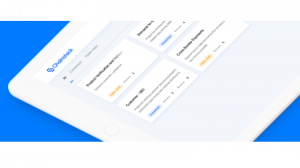

The primary conclusion: Corda and Hyperledger Fabric account for over 50% of all enterprise blockchain developer activity. “This is the first time that a time series analysis has been applied to comparing top protocols with any meaningful results – showing where the industry is heading now” said Laurent Dedenis, CEO at Chainstack.
Chainstack’s Enterprise Blockchain Protocols Evolution Index 2020
Captured over the span of several months, the Report provides:
- qualitative and quantitative insights into the trends and changes in the developer community
- activity related to the six most active publicly available enterprise protocols being built today – Corda, Hyperledger Besu, Hyperledger Fabric, Hyperledger Sawtooth, MultiChain and Quorum.
Among the key findings are:
- the unique number of developers contributing to enterprise blockchain deployment grew more than 12-fold from Q3 2016 to Q4 2019
- on average in 2018 and 2019, Corda and Hyperledger Fabric represented over 50% of all developer activities
- Hyperledger Fabric and R3’s Corda lead in terms of developer community size (they account for over 86% of total unique developers who ‘have pushed code’
- Quorum, the enterprise Ethereum fork developed by JP Morgan, mot only is growing fast but it doubled its number of active developers in 2019.
Methodology and implications
The Report uses a specific methodology to investigate all developer activities of open-sourced, general-purpose blockchain protocols hosted on GitHub. It then traces events, accounting for over 28,500 unique contributing developers. As the probable underlying foundational infrastructure, the six identified platforms are likely to host most of next generation of applications by which enterprises – from across many industries – hope to leverage decentralisation’s benefits.
Yet, in 2019, Gartner cited the highly fragmented state of the blockchain platform market as a major source of confusion for IT decision makers. Too much choice, in Gartner’s view, hampered technology choices in blockchain projects, thereby hindering the technology’s adoption.
By analysing platform developer engagement, the Report provides direct signals:
- not only the overall progress of specific technology uptakes
- the rate at which different platforms are evolving amidst industry changes.
In effect, Chainbase sees developer activity as a proxy for, or reflection of:
- the amount of resources which enterprises are dedicating to growing and evolving their blockchain codebase
- the extent of the community supporting the development of each these platforms/protocols.
This has relevance to enterprises. Using a protocols’ performance and longevity, enterprises can assess development data to evaluate the stability and maturity of each platforms before deciding on implementations.
Enterprise Times: what does this mean
By researching the previous lack of protocol developer-focused data in existing enterprise blockchain surveys, Chainstack hopes to offer enterprises, governments and developers the ability to make informed decisions before embarking on blockchain projects. By providing additional insight – into the technological maturity as well as support levels of each protocol – Chainstack seeks to overcome or bypass the concerns expressed by Gartner.
Furthermore, Chainstack says it will continue to track significant industry changes by:
- monitoring activity across enterprise blockchain protocols
- updating its Index annually.
When Enterprise Times read the Report, we had two reactions. The first is that the depth and usefulness, in its first iteration, is not as impressive as Chainstack would like to believe. The second is that the detail the Report does cover is like nothing else we have seen – and, therefore, still has value: the current Report carries more hints than real substance. We hope that the 2021 Report will improve. It will also be interesting to see if the next version picks up other platforms, for example Kadena or Multichain.


























